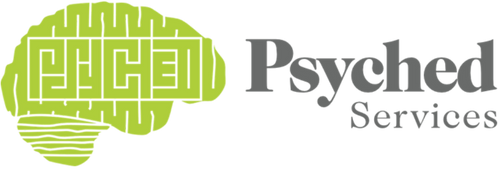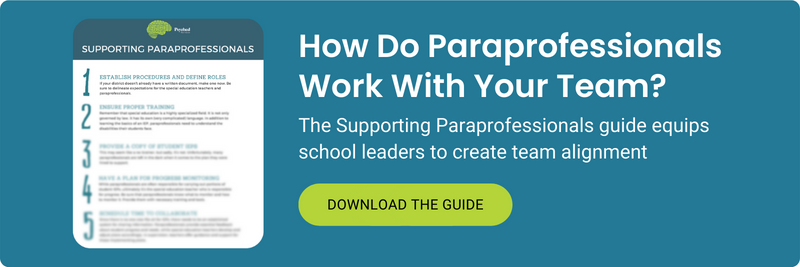Inclusive Practices That Work: Tips for Paraprofessionals

Listen up, sped team – we’ve got a challenge for you. Okay yes, we know that challenges are a dime a dozen in your world, but hear us out. This one is different. This one is something you can actually do something about. And when it’s all said and done, we think you’ll feel pretty good about it, too
It’s time to talk about the people on the front lines of special education: paraprofessionals. Along with special education teachers, they reflect the very core of programming; arguably the foundation upon which every IEP relies. But all too often, they are treated as though they are the IEP, and that just isn’t working.
We Need Paraprofessionals
Anyone who has worked with paraprofessionals knows how invaluable they are. Incase you haven’t heard, teachers are incredibly busy people. Class sizes are on the rise, as are time-consuming bureaucratic demands. Forget about lesson-plans, preparation, teaching, and grading for a moment. The time it takes teachers to complete mandatory paperwork and attend meetings could easily fill up a full day’s work each week.
For a general education teacher, that is.
When it comes to special education, teachers may spend two … or three … or (yes) even five days a week on those same tasks. And that’s where paraprofessionals come in. Ironically, the dream that drives many people to become teachers ends up being the very task they delegate to others: reaching the hard-to-reach so that every child can learn.
Current Trends
The US Department of Labor projects an 8% growth in the number of paraprofessionals in the next eight years. At the same time, research points to significant problems with the way special education paraprofessionals are used.
- Over reliance. Schools are increasingly looking to paraprofessionals as the first, rather than last, solution for obstacles in special education. This leads to high caseloads, which inevitably affects the quality of service paraprofessionals are able to provide.
- Inappropriate assignments. Paraprofessionals are often tasked with providing intensive academic and behavioral support without having been properly trained.
- Insufficient oversight. Paraprofessionals report making programming decisions, such as choosing instructional tools, methods for data-collection, and behavioral interventions, without the direct supervision and guidance of a special education teacher.
Legally, schools put themselves at risk when they allow these issues to go unchecked. In 2004, an Iowa school district was ordered to provide three years of compensatory education to a student whose paraprofessionals “were improperly responsible for the student’s instruction…”.
Why It Matters
Paraprofessionals spend a lot of time with kids. They are usually paired with a small group, or in some cases, only one child. Because of this, they have the opportunity to do what so many teachers wish they could do — really, as in REALLY, get to know their kids. They know what happens at home. They know what happens at school. They know their student’s friends (if they have any). They know their students work habits, moods, triggers, motivators, skill deficits, coping strategies … you get the idea.
In short, the insight paraprofessionals have is ESSENTIAL to IEP teams.
Which brings us to the point: Since there doesn’t seem to be a quick fix for teacher workloads, it stands to reason that we should adequately support the people coming in to help. With well-run systems in place, everyone wins.
Inclusive Practices That Work
All those things we just mentioned – the things paraprofessionals know about kids – those are the things teachers need to know so they can create plans that work. Because of this, paraprofessionals are in the PERFECT position to help kids. But to do so, they need to know how to help, so here is a list of suggestions to get you started:
- Establish procedures and define roles – If your district doesn’t already have a written document, make one now. Be sure to delineate expectations for the special education teachers and paraprofessionals.
- Ensure proper training – Remember that special education is a highly specialized field. It is not only governed by law, it has its own (very complicated) language. In addition to learning the basics of an IEP, paraprofessionals need to understand the disabilities their students face.
- Provide a copy of student IEPs – This may seem like a no-brainer, but sadly, it’s not. Unfortunately, many paraprofessionals are left in the dark when it comes to the plan they were hired to support.
- Establish a plan for monitoring progress and adjust the plan as needed – While paraprofessionals are often responsible for carrying out portions of student IEPs, ultimately it’s the special education teacher who is responsible for progress. Be sure that paraprofessionals know what to monitor and how to monitor it. Provide them with necessary training and tools.
- Set aside time for supervision and collaboration – Since there is no one-size-fits-all for IEPs, inclusive education can look many different ways. For plans to work, there needs to be an established system for sharing information. Paraprofessionals provide essential feedback about student progress and needs, while special education teachers develop and adjust plans accordingly. In supervision, teachers offer guidance and support for those implementing plans.
DO’s and DON’Ts for Para-led Support
- DO use paraprofessionals to support differentiated instruction by having them run a small group.
- DON’T ask a paraprofessional to run a small group if they have not been properly trained and don’t expect them to create a lesson on their own.
- DO use student strengths to support goals and build confidence.
- DON’T over-prompt. If a child doesn’t have the chance to try a skill, they may never use it on their own.
- DO use peers to support instruction. Look for others who are the same age, have strong social skills, and can model what another student is working to learn.
- DON’T stigmatize children – be discrete when pulling them into an alternate instruction.
- DO incorporate fun into the instruction. It doesn’t have to be boring to be effective (in fact, the opposite is true).
- DON’T stress if a child is not picking up a concept. Work with the teaching team to adjust instruction and support as needed.
- DO work with students other than those on the caseload. Becoming a part of the classroom helps establish relationships among kids with and without disabilities.
- DON’T discuss a child’s struggles in front of other children or give feedback unless all peers are receiving feedback. Make a note to communicate with the teacher or student at a later time.
- DO get on a child’s level. If students are working on the floor, get on the floor. If they are at a desk, sit beside them (instead of above them in an adult-sized chair). If they are in a circle with peers, join the circle, etc.
- DON’T get stuck in a rut. If a child is thriving, it may be time to discuss decreasing support and increasing time spent in inclusion. If the child is struggling, it may be time to increase support.
- DO have fun. Get to know the kids, make their days special, and enjoy the relationships you will build. They will likely remember you for the rest of their lives.
Paraprofessionals are essential to effective special education teams. By preparing them, appreciating them, and supporting them, schools become more successful and kids thrive.





